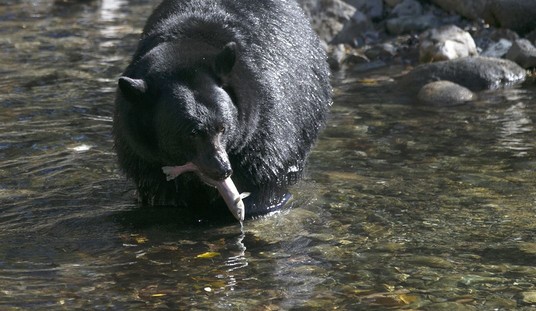God willing, the Gulf Coast may be spared Prince-William-Sound-like images of waves of tarry goo slapping ashore, while wild birds and cuddly mammals struggle for survival in asphaltine muck.
Last Friday, the Lafayette Daily Advertiser reported on the rescue of the first oil-covered bird Louisiana:
It was the only animal being cleaned late Friday morning, but rescuers expected many more to come in throughout the day.
Hmmm. Seen any more pictures? Me either.
Today’s news brings reports of dead jellyfish …
… it’s not uncommon to see jellyfish floating dead during high winds, but the number of dead found so far is beyond normal.
and sea turtles in Mississippi, at least 25 miles from the leading edge of the advancing oil.
Although this is the time of year when dead turtles are often found on the beach, scientists say the number is more than double what they would expect.
What gives?
Several factors may be at play in diminishing the shore impact of the current spill.
- Natural wave action will aerate and break up the slick. Chemical dispersants are being applied to speed up the process.
- The oil is lighter than the Alaskan crude from the Valdez spill, and hence is more prone to evaporate.
- The source of this spill is in open water some 50 miles from the nearest land, so the dispersants, the responders and Mother Nature have some time to do their thing before landfall.
If we apply a few calculations, we can figure out how dispersed the oil might be.
BP’s estimate is that the well is making some 5,000 barrels of crude oil per day. For convenience, we’ll say the well has been flowing for 14 days, or 70,000 barrels total. One barrel is 5.615 cubic feet, so the total volume of spilled oil is something like 400,000 cubic feet.
Let’s say the size of the spill is 50 miles by 50 miles, or 2,500 square miles. (Actually, the size of the spill’s extent as shown in the New York Times graphic below is more like 5,100 square miles. I’ve embellished the original NYT graphic to depict these theoretical & estimated areas.)
Four hundred thousand cubic feet of oil over 2,500 square miles is 160 cu ft per square mile, or just 1/4 cubic foot per acre. Spread uniformly over the entire 50 mi x 50 mi area, that would equate to a layer of oil 0.00007 inches thick.
And that’s if none of the oil has evaporated, which it has.
As we’ve seen in the pictures, the oil does tend to clump up in thicker ribbons. But the fact remains that much of the 5,100 sq mi is covered by “sheen”, which is what you get on the surface of a swimming pool if you go in after applying a generous layer of Coppertone.
None of this is intended to minimize the potential for damage to specific populations and localized areas. For example, a brown pelican rookery was devastated just a few years ago by a small volume of oil spilled in a very vulnerable place at a very vulnerable time.
As disappointing as it may be to some journos and enviros, the jellyfish and the sea turtle kills may well turn out to be natural events, unrelated to the oil spill. I’m praying that this spill event will end in the near future without a calamitous impact on either the wildlife or the human population of the Gulf Coast.
Cross-posted at VladEnBlog.













Join the conversation as a VIP Member